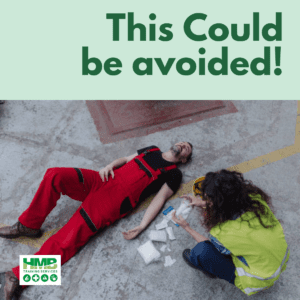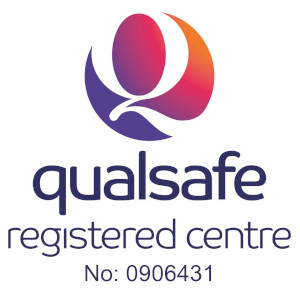How to Prevent Injuries at Work
Accidents and injuries can happen at any time. We have created the five steps to prevent injuries and accidents at work. Accidents can have serious consequences on our health and well-being. While we can’t control everything around us, there are steps we can take to prevent injuries and accidents from happening in the first place.
By being aware of potential hazards and taking the necessary precautions, we can greatly reduce the risk of getting hurt. In this blog, we will discuss some practical tips on how to prevent injuries and accidents, and how you can make safety a top priority in your workplace.
Statistics in the Workplace
- According to the Health and Safety Executive (HSE), there were 693,000 non-fatal injuries to workers in the UK in 2019/20.
- The HSE also reported that in the same year, there were 111 fatal injuries to workers in the UK.
- In 2020, St John Ambulance reported that only 4 in 10 people in the UK knew basic first aid.
- In the same year, the Royal Society for the Prevention of Accidents (RoSPA) reported that around 6,000 people die each year in the UK as a result of accidents in the home.
- The British Red Cross reported that falls are the most common cause of accidental injury in the UK, with over 220,000 hospital admissions each year.
These statistics underscore the importance of knowing basic first aid skills and taking steps to prevent accidents from happening in the first place. By being prepared and informed, we can help reduce the number of accidents and injuries that occur each year in the UK.
Accidents V’s Injuries
Accidents and injuries are unfortunately a common part of life that can have serious consequences for those involved.
An accident is an unexpected and unintentional event that occurs due to various reasons, such as human error, environmental factors, or mechanical failure.
Injuries, on the other hand, are the physical harm that results from an accident, ranging from minor cuts and bruises to severe damage such as broken bones, head trauma, or even death. These can occur in various settings, such as at home, in the workplace, on the road, or during recreational activities.
Accidents and injuries can have far-reaching impacts on individuals, workforce, and society as a whole, leading to physical, emotional, and financial burdens. Therefore, it is important to take preventive measures such as adhering to safety guidelines, following traffic rules, and maintaining a healthy lifestyle to reduce the risk of accidents and injuries.
Potential Hazards in the Workplace
The top hazards in the workplace can vary depending on the industry, but some common hazards include, slips and trips and falls, manual handling, machinery, electrical, chemical, fire, ergonomic an biological hazards.
Slip, trip, and fall hazards: These can be caused by wet or slippery surfaces, cluttered walkways, or uneven flooring. Manual handling hazards: These can occur when lifting, carrying, or moving heavy objects, leading to strains, sprains, or other musculoskeletal injuries.
Manual handling hazards: These can occur when lifting, carrying, or moving heavy objects, leading to strains, sprains, or other musculoskeletal injuries.
Machinery hazards: These can be caused by improperly guarded machinery, inadequate maintenance, or lack of training on how to operate machinery safely.
Electrical hazards: These can be caused by exposed wiring, damaged electrical cords, or improper use of electrical equipment.
Chemical hazards: These can occur when working with hazardous substances such as cleaning agents, solvents, or industrial chemicals.
Fire hazards: These can be caused by improperly stored flammable materials, damaged electrical equipment, or smoking in prohibited areas.
Ergonomic hazards: These can occur when workers are required to perform repetitive motions, work in awkward postures, or sit or stand for long periods.
Biological hazards: These can be caused by exposure to viruses, bacteria, or other infectious agents, such as in healthcare settings or animal handling.
It’s important for employers to identify and assess potential hazards in the workplace and take appropriate measures to control or eliminate them to ensure the safety of their workers.
Common injuries in the Workplace
The top 5 injuries at work are:
- Slips, trips, and falls: These types of injuries are very common and can happen in any workplace. They often result from wet or slippery floors, uneven surfaces, poor lighting, or obstacles in walkways.
- Strains and sprains: These injuries occur when muscles, tendons, or ligaments are stretched or torn due to overexertion, repetitive motions, or lifting heavy objects. They are often seen in occupations that involve manual labour, such as construction or manufacturing.
- Cuts and lacerations: These injuries can result from working with sharp tools or equipment, handling glass or metal, or using machinery with exposed parts.
- Bruises and contusions: These types of injuries are caused by blunt force trauma and can result from falling objects, colliding with equipment or vehicles, or being struck by a heavy object.
- Respiratory problems: Workers who are exposed to hazardous chemicals, dust, or fumes can develop respiratory problems such as asthma, bronchitis, or lung disease. These types of injuries are often seen in industries such as manufacturing, construction, and mining.
It is important for employers to implement safety measures to prevent these types of injuries and protect their employees. This can include providing appropriate training, personal protective equipment, and enforcing safety protocols.
The five steps to prevent injuries and accidents at work
The following are five steps that employers and employees can take to prevent injuries and accidents at work:
- Identify hazards: Employers should conduct regular safety inspections to identify potential hazards and take appropriate measures to eliminate or minimise them. Risk assessments should be followed to identify risks and measurements followed to eliminate accidents happening. Employees should also be encouraged to report any safety concerns or hazards they notice.
- Practice good housekeeping: Employers should maintain a clean and organised workplace to prevent slips, trips, and falls. This includes regularly cleaning spills, removing debris, and keeping walkways and stairways clear. Employees should also take responsibility for keeping their work areas clean and tidy. While keep a clean environment report any faults and any hazards that could cause injury.
- Encourage a safety culture: with employees reporting faults and hazards, employers should foster a safety culture where employees feel comfortable reporting safety concerns, are recognised for safe behaviour, and are held accountable for unsafe actions. Employees should also be encouraged to participate in safety talks and offer suggestions for improving safety practices.
- Conduct regular safety training: Employers should conduct regular safety training sessions for employees to ensure that they are aware of potential hazards and understand how to use equipment and follow safety protocols. This includes new employee orientations, refresher courses, and ongoing training as needed.
- Use personal protective equipment (PPE): Employers should provide and require employees to use appropriate personal protective equipment, such as gloves, safety shoes, safety glasses, hard hats, and respirators, when necessary. Employees should also use PPE as instructed and ensure it is in good condition.
In conclusion to the five steps to prevent injuries and accidents at work, preventing injuries and accidents at work is a shared responsibility between employers and employees. By following the five steps outlined above, including identifying hazards, providing training and personal protective equipment, practicing good housekeeping, encouraging a safety culture, employers and employees can work together to create a safer and healthier work environment.
Additionally, by implementing additional steps such as developing and communicating safety policies and procedures, conducting regular safety training, encouraging physical and mental wellness, and conducting incident investigations, employers can further reduce the risk of accidents and injuries.
Ultimately, creating a culture of safety requires ongoing commitment and effort, but the benefits of a safer workplace are well worth it, including increased productivity, reduced costs, and most importantly, keeping employees safe and healthy.
Furthermore, preventing injuries and accidents at work is not only important for the safety and health of employees, but it also benefits the employer in numerous ways.
For instance, it can increase employee morale and job satisfaction, reduce employee turnover, improve overall productivity, and minimise costs associated with workplace injuries and accidents such as medical expenses, lost work time, and insurance premiums. By prioritising safety and taking proactive steps to prevent accidents and injuries, employers can create a more efficient, effective, and successful workplace.
Moreover, preventing workplace injuries and accidents is not only the responsibility of employers and employees, but it is also a legal obligation. HSE mandates that employers provide a safe workplace free of recognised hazards, and failure to comply with safety regulations can result in significant fines and penalties. Therefore, it is crucial for employers to take safety seriously and take proactive steps to prevent workplace injuries and accidents.
Further Training
We offer a range of first aid courses for all ages from workplaces to education.
Our current first aid courses;
- Emergency First Aid at Work
- First Aid at Work
- Emergency Paediatric – one day
- Paediatric – two day
- Parents’ first aid – 2-3 hours
- Children’s first aid – 2 hours – ages 8 plus
Our Emergency and First Aid at Work courses are for those working in an office, factory, warehouse, manufacturing or on a building site. These courses will set you up to know exactly what to do in an emergency. Completing our courses will help you understand the hazards and risks in your workplace to therefore prevent accidents.
Apprentices or staff who are unlikely to be left alone with children, and lunchtime supervisors are all candidates for our Emergency Paediatric First Aid Training. Our one-day course includes roles and responsibilities of a first aider, first aid kits, accident reporting, reasons of a life-threatening condition, CPR, defibrillator, causes of unconsciousness and recovery position, choking, bleeding, burns, and minor injuries.
Our Paediatric First Aid Training 2-day course includes all elements of the one-day first course including; broken bones, spinal injuries, head injuries, slings, sprains and strains, diabetes, febrile convulsions, hypothermia, hyperthermia, epilepsy, poisons, eye injuries, allergies and anaphylaxis, and asthma.
This course is ideal for those working alone with children, whether you are a Teacher or Teaching Assistant working in the Early Years or a childminder. Our Paediatric courses are fully accredited. We have open courses running at our Brownhills Centre or we can come to your setting.
Additionally, if you prefer to have a short session with us and complete a bespoke parents/grandparents course; our Parent’s first aid course is for you. These start from 2 hours up to 4 hours. Can include any modules of your choice, but we will cover: reasons of life-threatening conditions, CPR, Defibrillator, unconsciousness, recovery, choking and gagging, burns, and minor illnesses, including dangers within the home.
Our courses provide you with the peace of mind that you’ll know what to do in the event of an emergency, such as illnesses like asthma. Furthermore, getting first aid training will give you the skill set of knowing exactly what to do if your child, friend, or work colleague suffers from an injury or life threatening condition. Never put yourself in a situation where you’re thinking, “What if I knew what to do?” Get First Aid Trained Today!



